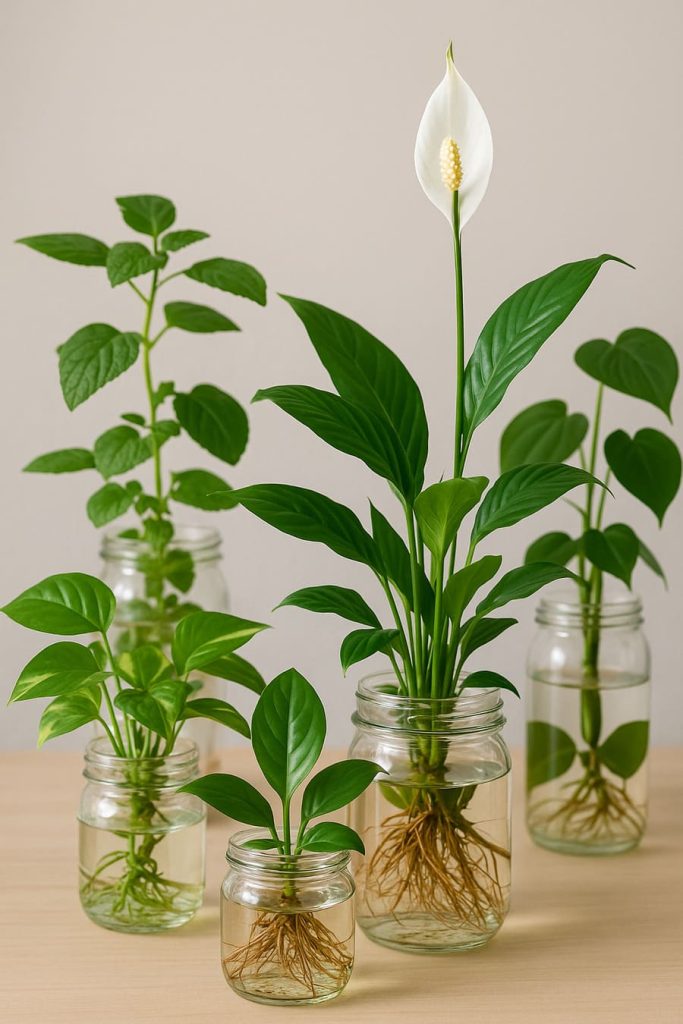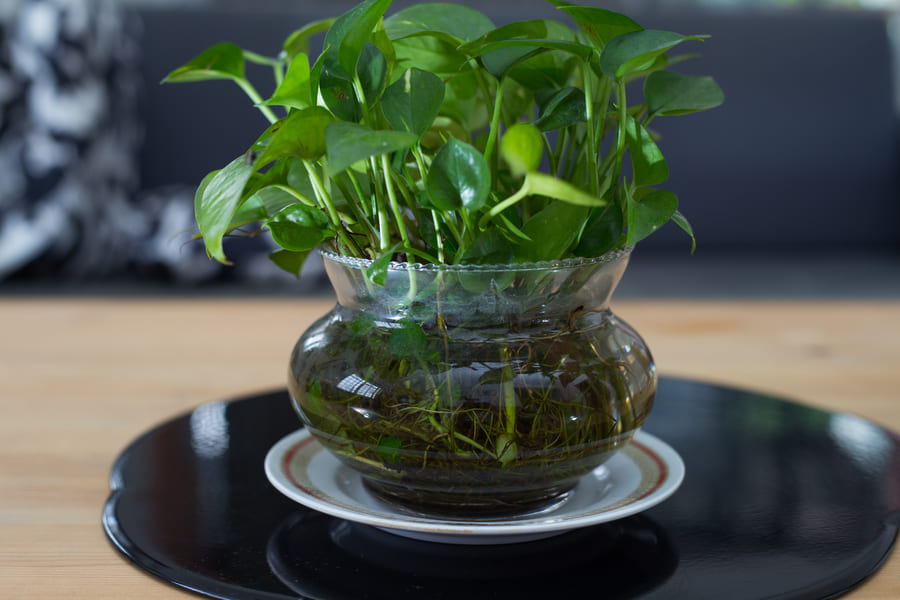Were you aware of the fact that some plants can grow to their full potential without needing soil? All they need is water to flourish. Growing plants with water is a creative method (also referred to as hydroponics) that gives gardeners or other busy plant lovers a fantastic option to grow numerous plants without the mess of soil easily in their indoor spaces and without much of a fuss. In this article, you’ll discover 15 amazing and low-maintenance plants that can thrive exceptionally well in water.
Benefits of Growing Plants in Water
Aesthetically Appealing: These plants look beautiful with their roots popping out of the glass containers or small planters, which makes them an ideal addition to enhance the aesthetic appeal of your spaces.
Low Upkeep: With this method of gardening, you don’t have to worry about the soil mess, overwatering, or even soil pests or other maintenance issues. In fact, water-grown plants rarely encounter any pest or disease-related problems. This gardening method is also eco-friendly because it uses less water compared to traditional soil gardening .
Ideal for Limited Spaces: Don’t have much of the space to start your garden? Worry not, water-grown plants can effectively flourish indoors in limited spaces, which makes them an amazing choice for people with limited spaces.
15 Amazing Plants That Can Thrive Well in Water

Peace Lily (Spathiphyllum)
This plant is stunning with attractive white flowers which are known for their air-purifying characteristics. Just place the roots in a glass container with sufficient water to cover them. Don’t keep the peace lily in direct light, this plant prefers indirect light, and change the plant’s water after every 2 weeks to preserve its freshness. Putting a few drops of any hydroponic fertilizer will actually help the plant thrive. With time, the roots will expand, so you may have to re-pot it every year in order to keep it healthy.
Lucky Bamboo (Dracaena Sanderiana)
Despite its name, this plant is not bamboo but a kind of Dracaena and is often linked with good fortune. For lucky bamboo, always add filtered water in a vase to avoid chemicals, and change it after every two weeks. They need low to moderate light to flourish, which makes them an elegant and low-maintenance addition for any room.
Spider Plant (Chlorophytum Comosum)
This plant grows exceptionally well in water. Briefly cut the “pups” out of the main plant and put them in a jar of water. Spider plants perform extraordinarily in various indoor settings and lead to better air quality. Ensure the cutting base is totally submerged in water and do change the water on a regular basis. They prefer indirect and bright light, yet they can also tolerate lower light settings.
Philodendron (Philodendron spp.)
This plant is adaptable and can easily adjust to different growing conditions. To grow philodendron, put a cutting with some leaves in a water container. Philodendrons require indirect light and they grow extremely fast which makes them an excellent choice for indoor gardens.
Mint (Mentha)
This herbal plant is the perfect choice to grow in water for culinary usage. To grow mint, take a cutting from established plants with some leaves and put it in a container of water. Mint thrives well in bright and indirect light and can be collected daily for cooking or other uses. To keep the plant healthy and thriving, change its water frequently.
Pothos (Epipremnum Aureum)
This houseplant is easy-to-care for and loves thriving in water. To grow pathos in water, just take a cutting with one node and put it in a water jar. Pothos prefer indirect light and grow rapidly, which makes them favorites for both experienced and beginner-level gardeners. Don’t forget to change its water after every few days to keep it flourishing and healthy.
Basil (Ocimum Basilicum)
This herbal plant is famous for its culinary uses and fragrant leaves. To grow basil in water, take a cutting from an already established plant and put it in a water jar. Basil requires bright light setting to thrive and can be gathered daily for cooking use. Ensure to change the water as frequently as possible to avoid stagnation and keep it healthy.
Snake Plant (Sansevieria Trifasciata)
This plant is known for its hardiness and low-upkeep qualities as it can thrive in water with just minimal effort. To grow snake plant, cut down the leaf close to the base and put it in water, make sure the cutting is totally submerged in water. Snake plant is also famous for its air-purifying qualities, which help to remove toxins from the air.
Rosemary (Rosmarinus Officinalis)
This herbal houseplant is famous for its aromatic foliage and culinary use. What makes rosemary stand out is its low-upkeep nature. It can grow even in low light settings, which makes it an excellent option for indoor gardening. To grow rosemary, simply take a cutting with some leaf nodes and put it in a water vessel. Don’t forget to change the water frequently to avoid the algae development and to provide the plant with enough nutrients.
Begonia (Begonia spp.)
Begonia is known for its diverse color range and patterns. To grow this plant in water, simply take a cutting and put it in a water container. This plant prefers bright and indirect light to thrive well and can add an aesthetic touch to your indoor space. Don’t forget to change the water frequently to maintain the plant’s health and growth.
Thyme (Thymus Vulgaris)
Another herbal plant is thyme, which grows well in water, and is popular for its multiple uses, including culinary. To grow thyme, simply place cutting in a water jar and make sure it’s totally submerged in water. Thyme prefers bright and indirect light. Ensure to change the water after every 3 to 5 days.
Geranium (Pelargonium)
This houseplant has stunning flowers and grows well in water. To grow geranium, simply add cuttings in a water jar along with some leaves, ensure it’s totally submerged in water. This plant requires bright and indirect light to thrive. Change the plant’s water frequently to avoid the algae and bacteria growth and keep it healthy.
Coleus (Plectranthus Scutellarioides)
This plant has vibrant and colorful foliage that grows rapidly in water. To grow coleus, take a cutting with some leaves and put it in a water jar. It requires bright and indirect light to thrive well but can also thrive in lower light settings. Change its water after every two weeks, and don’t forget to fertilize on a monthly bases for optimal growth.
Oregano (Origanum Vulgare)
Oregano is another herbal plant that easily roots in water and is known for its diverse culinary uses. To grow this herbal plant, just take a cutting and put it in a water jar. It needs bright and indirect light setting to thrive. Remember to change the water frequently for healthier growth.
Lavender (Lavandula)
Our final purposeful herbal indoor plant that thrives well in water is lavender. Lavender not only looks stunning but also has various range of uses. Grow this plant in your indoor space to give a lovely touch of color to your space. To grow lavender, add cuttings with some leaves in a water jar. This plant requires bright and indirect light for optimal growth. Don’t forget to change plant’s water after every few weeks to prevent bacteria growth.
How to Care for Water Plants
Pick the Right Container: Frankly speaking, any vessel that can hold water will be perfect to grow your plants. But glass containers are ideally the best choice because of their aesthetic appeal, and you can see through the plant’s roots. Please be careful since glass is vulnerable to algae blossoms so you should opt for the opaque vase to avoid maintenance-related issues.
Focus on Light Needs: Before planting, do consider and verify the plant’s needs, such as how much exposure to light is required for each type of plant. Different plants require different amounts of sunlight exposure, while some need shade to grow.
Change the Water Frequently: Don’t neglect to drain and refresh your plant’s water on a regular basis, like after every 10 to 15 days (it’s best to opt for chlorine-free water if you can), particularly If it begins to look dirty and murky.
Add Fertilizers: For optimal growth, don’t neglect the importance of fertilizers. Add liquid fertilizer to your indoor water plants 2 to 3 times each year or each season.
Final Thoughts
Remember, these plants can be an amazing and aesthetic addition to any indoor space. With this list in your hands, you are all set to kick-start your own indoor water plants garden. Good Luck!
So, which plant out of these do you want to grow in your indoor space? Drop your valuable comments below, and let us know!

Numrah Fareed is a freelance writer and home organization enthusiast with a passion for practical, eco-friendly living. When not typing away at her desk, she’s experimenting with DIY cleaning hacks and helping readers simplify their routines one tip at a time.
